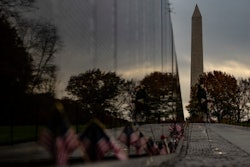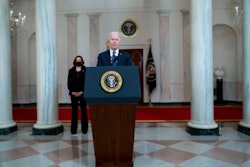Today begins the Games of the XXXII Olympiad—branded as Tokyo 2020 despite taking place in the year 2021—with opening ceremonies broadcast across the globe followed by two full weeks of athletic competition in nearly three dozen sports. Young people from roughly 200 countries will gather to compete after more than a year delay due to the global COVID-19 pandemic.
American sports fans—including yours truly—have been especially interested in the buildup of stories about the heavily favored women of Team USA.
The U.S. women's soccer team (politics aside) is again a heavy Olympic favorite. Sydney McLaughlin and DeAnna Price are considered tops in their track and field events. Aliphine Tuliamuk is one to watch in the Marathon. Katie Ledecky is like lightning in the water. And Simone Biles is, well, Simone Biles—she's almost a lock for gold.
American sports fans—including yours truly—will be rapt with attention to the well-woven stories of the athletes' dreams of triumph, dedication to training, and dazzling performance.
NBC has been broadcasting the Olympics in the United States for years, and while the network gets a great many things wrong, they tend to do very good work in their Olympic Games storytelling.
Of course, some storylines are rife with conflict, controversy, and change.
The first ever competitor born as a male will compete as a female. One female member of Team USA cravenly dismissed the National Anthem and turned her back on the flag in the run-up to the games. Another American female athlete was left home because she smoked Marijuana after hearing of her mother's death. And the U.S. women's soccer team kneels in support of Black Lives Matter.
It just so happens that we're just months away the 50th Anniversary of Title IX—landmark legislation signed by President Richard Nixon in 1972 that decreed, "No person in the United States shall on the basis of sex, be excluded from participation in, be denied the benefits of, or be subjected to discrimination under any educational program or activity receiving Federal financial assistance."
It's an indisputable fact that without Title IX the American women in Tokyo would not be such a force to be reckoned with during the Olympic Games—but they are, and that's an awesome achievement.
All that being said, this week's column isn't about the Olympic Games, Team USA, or women's sports.
This week's column is about women in law enforcement—in this instance, sports is a useful metaphor.
Let's review some of the passages used in the opening paragraphs: "dreams of triumph, dedication to training, and dazzling performance." What about "a force to be reckoned with" and "an awesome achievement" or "conflict, controversy, and change"?
Those turns of phrase should sound eerily familiar because the same words can be said in the context of women in law enforcement.
A History of Heroines
Across America, women in law enforcement perform heroic acts of courage and compassion on a daily basis. In nearly every instance, their efforts go unnoticed except by those immediately impacted—the victims of crime and the criminals responsible—but sometimes these accomplishments make the news.
Female police officers across America rarely perform their acts of heroism with a "live audience" but are almost always under the ever-present eye of cameras mounted to the dash of their patrol car, their uniforms, the eaves of the nearby buildings, and in the mobile phones of nearby witnesses.
The overwhelming majority of these incidents captured on video show the heroism and professionalism of the women involved. Only once in a long while does a "cringeworthy" tape surface (turns out that women are as fallible as men—who knew?).
Alice Stebbins Wells is widely considered to be the first sworn female police officer in the United States, joining the Los Angeles Police Department in 1910—some argue that it was Lola Baldwin of the Portland (OR) Police Department to have first held such a role. Isabella Goodwin became New York City’s first female detective in 1912 and Constance Kopp was hired as New Jersey’s first female deputy sheriff in 1916. Many other notable benchmarks followed.
In the 100+ years between then and now, police women have patrolled alongside their male counterparts, putting their lives on the line for the communities they serve, and sadly altogether too many female officers have been killed in the line of duty.
Earlier this year, Corporal Christine Peters of the Greenbelt (MD) Police Department succumbed to injuries sustained when she was struck by a vehicle.
Officer Alexandra Brenneman Harris of the Seattle Police Department was fatally struck by a vehicle helping other officer while she was off duty.
Officer Sarah Ann Backer-Grell of the Minnesota Department of Natural Resources died in a vehicle collision.
Detective Jamie Huntley-Park—and her husband, Ryan Park—of the San Diego Police Department died when their department vehicle was struck head-on by a wrong-way driver.
FBI Special Agent Laura Ann Schwartzenberger was shot and killed while executing a search warrant in Florida.
At least seven female law enforcement officers have died in 2021as a result of COVID-19.
An unknown number of female officers have been injured on duty so far this year.
Final Words
Women in policing have their own version of Title IX.
In 1972, Congress passed an amendment to the Civil Rights Act of 1964—dubbed Title VII—prohibiting police agencies from job discrimination based on gender, paving the path for women to join the ranks in based in much greater numbers.
In time, women began advancing into leadership positions.
In 1985 Penny Harrington of the Portland Police Bureau became the first female chief of a major metropolitan department in the United States. Most recently, Estella Patterson has been named Police Chief of the Raleigh (NC) Police Department. A number of others—such as Erika Shields (Atlanta (now Louisville)), Susan Ballard (Honolulu), Heather Fong (San Francisco), Carmen Best (Seattle), and Jane Castor (Tampa)—have held the spot of top cop in major cities.
Still, women make up only about 12 percent of sworn officers and female police leaders remain the exception and not the rule—there is a great deal of room for improvement here—and a tiny fraction of people in position of police leadership are female.
According to data from Statista, ten industrial countries rank ahead of the United States in this area—27% of officers in the United Kingdom are women, 25% of officers in Ireland are women, and 24% of officers in Norway are women. The Netherlands, Canada, Germany, and others follow in the list ahead of America.
There is a great deal of room for improvement here indeed.
Agencies across the country recently signed a pledge to increase to 30% the ranks of women in recruit classes by 2030. The stated goal of the so-called 30x30 Initiative is to increase the number of women in policing and "ensure police policies and culture intentionally support the success of qualified women officers throughout their careers."
The reasoning, in part, is that believed women are believed to have high levels of interpersonal communication skills, which can aid in de-escalation highly volatile situations, potentially resulting in fewer use-of-force cases.
It remains to be seen if these theories prove accurate in practice, but the effort to find out is underway.
Still, women make up only about 12 percent of sworn officers and female police leaders remain the exception and not the rule—there is a great deal of room for improvement here—and a tiny fraction of people in position of police leadership are female.
According to data from Statista, ten "industrial" countries rank ahead of the United States in this area—27% of officers in the United Kingdom are women, 25% of officers in Ireland are women, and 24% of officers in Norway are women. The Netherlands, Canada, Germany, and others are ahead of America here.
There is a great deal of room for improvement here indeed.
Agencies across the country recently signed a pledge to increase to 30% the ranks of women in recruit classes by 2030. The stated goal of the so-called 30x30 Initiative is to increase the number of women in policing and "ensure police policies and culture intentionally support the success of qualified women officers throughout their careers."
The reasoning, in part, is that believed women are believed to have high levels of interpersonal communication skills, which can aid in de-escalation highly volatile situations, potentially resulting in fewer use-of-force cases.
It remains to be seen if these theories prove accurate in practice, but the effort to find out is underway.
There's some solace in the fact that it wasn't too long ago that female athletes in the Olympic Games were overshadowed by their male teammates—now Team USA women are attracting a great deal of excitement and attention even among passive sports fans.
Perhaps this portends an even brighter future for females on the force who wear a badge and a gun not for glory or gold, but for their love of country and community—for their commitment to the safety of the public they've sworn to protect.
Be well and stay safe my friends.
















